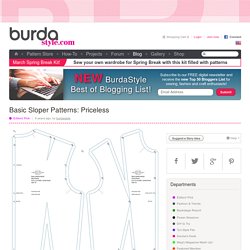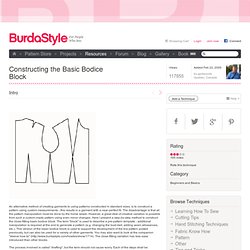

Basic Sloper Patterns: Priceless – Sewing Blog. Do you own any basic slopers or pattern blocks?

Well, if you went to fashion school, you do, and you know how incredibly useful they are. But if you didn’t- well perhaps you don’t have to go to school for this, with the resources available to the sewing community these days. Every single piece of clothing that is not draped is derived from a basic pattern block or sloper.
I must stress the importance of creating your own, customized slopers. Once you have taken the time to create your basic patterns (designed off of your personal measurements or your fit model’s measurements) you can make anything. Here is a Bodice Sloper that you can use to develop top and blouses from, and then add on the Skirt Sloper sloper to make a dress! Or you can isolate the skirt to create all types of skirt designs! Into sewing with knits? If you already want a sloper that is a dress, here are TWO different silhouette to choose from: The Fitted Dress Sloper, and then the Shift Dress Sloper.
Drafting the Basic Skirt – Learning Sewing. Along with the drafting blocks for a bodice (" dress (" and trousers (" a block for a skirt represents a rather straightforward use of the approach, as the adjustments for different measurements are relatively simple. Of course, once a basic skirt shape has been found, a vast variety of variations can be constructed. As for the other drafting techniques, you'll need large sheets of paper (I use large newsprint blocks of the cheapest quality), a pencil and eraser, a yard or meter ruler, a smaller ruler, a square and a "French curve" that can be replaced by sliding a dinner plate along, to produce a nice smooth curve.
A calculator is useful, in addition. You will also need a set of body measurements (waist, hips, and waist-to-hip distance), and waist-to-knees distance. The latter is necessary only to determine the length of the dress. Constructing the Basic Bodice Block – Learning Sewing. An alternative method of creating garments to using patterns constructed in standard sizes, is to construct a pattern using custom measurements - this results in a garment with a near-perfect fit.

The disadvantage is that all the pattern manipulation must be done by the home sewer. However, a great deal of creative variation is possible from such a custom-made pattern using even minor changes. Here I present a step-by-step method to construct the close-fitting basic bodice block. The term "block" is used to describe a pre-pattern template - additional manipulation is required at the end to generate a pattern (e.g. changing the bust dart, adding seam allowances, etc.). This version of the basic bodice block is used to support the development of the bra pattern posted previously, but can also be used for a variety of other garments. The process involved is called "drafting", but the term should not cause worry. Constructing the Basic Trouser Block – Learning Sewing. Trousers (or pants or slacks) require their own block, distinct from the basic blouse block ( and the dress block ( presented earlier, Here I present detailed, step-by-step instructions for preparing a custom-fitted trouser block for women.

A man's trouser block is slightly different, although not dramatically so - it is possible to work with a women's trouser block and adjust it somewhat to get a fit to a man's body. As in my earlier techniques, you will need a ruler about a meter long, a smaller ruler, a sharp pencil, and a French curve (or dinner plate!). A calculator is useful, in addition. You will also need a set of body measurements (waist, hips, waist-to-hip distance, waist-to-ground distance, body rise (distance from the waist to the chair when you are sitting down), and waist-to-knees distance. With the first four measurments, the others can be estimated. 57447. Drafting Sleeve for Basic Bodice Block – Learning Sewing.